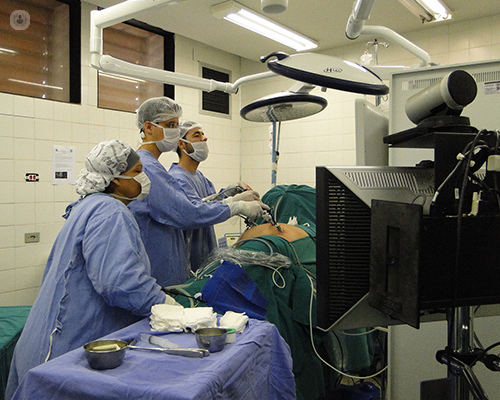Exploring the impact of minimally invasive surgery on patient outcomes
Escrito por:Minimally invasive surgery represents a significant advancement in surgical techniques, offering several benefits over traditional open surgery.
Here, Mr Danilo Miskovic, renowned consultant general and colorectal surgeon, explains what minimally invasive surgery is, how it differs from traditional surgery, as well as its impact on patient outcomes.

What is minimally invasive surgery?
Minimally invasive surgery refers to surgical techniques designed to minimise the size and number of incisions needed to perform a surgical procedure. Unlike traditional open surgery, which requires large incisions to access the surgical site, minimally invasive surgery uses small incisions and specialised instruments, often guided by a camera.
Some common examples of minimally invasive surgeries include laparoscopic surgery, endoscopic surgery, robot-assisted surgery, and arthroscopic surgery.
Minimally invasive surgery is particularly advantageous for a range of conditions, including gallbladder removal (cholecystectomy), hernia repair, certain gynaecological surgeries, orthopaedic procedures, colorectal surgeries, urological surgeries and certain cardiac procedures.
How does minimally invasive surgery differ from traditional open surgery?
Minimally invasive surgery differs significantly from traditional open surgery in several key aspects, including the approach to accessing the surgical site, recovery time, and overall patient experience. Here are the main differences:
Smaller incision size: Minimally invasive surgery uses small incisions, typically ranging from 0.5 to 1.5 centimetres, which results in smaller scars. In contrast, traditional open surgery requires larger incisions, leading to more significant scarring.
Increased visualisation and precision: Minimally invasive surgery employs a camera (laparoscope) and specialised instruments. These are inserted through the incisions, providing high-definition, magnified views of the surgical area. The surgeon then operates using these instruments while viewing the surgical area on a monitor. In contrast, traditional open surgery relies on the surgeon’s direct line of sight and manual access to the surgical site in order to operate.
Shorter recovery times: Minimally invasive surgery typically results in shorter hospital stays and a quicker return to normal activities due to less tissue damage and smaller incisions. There is also a reduced need for pain medication post-surgery. In contrast, traditional open surgery typically involves longer hospitals stays and extended recovery times, with higher requirement for pain management post-surgery.
How should patients prepare for minimally invasive surgery?
Proper preparation is crucial for the success of minimally invasive surgery. Patients should follow their surgeon’s instructions carefully, which may include specific preoperative tests and evaluations.
A comprehensive review of the patient's medical history and a physical examination are conducted during the initial consultation to ensure they are suitable for surgery. Blood tests are also ordered to check for any underlying conditions that could surgery or recovery. Imaging studies, including X-rays, CT scans, or MRIs, provide detailed views of the surgical area.
Medication review with the surgeon is also necessary, as some medications may need to be stopped or adjusted before surgery. Fasting for a designated period beforehand is usually required to minimise anaesthesia-related risks. Planning transportation to and from the hospital and arranging necessary support during the initial recovery phase at home is essential.
What can I expect during the recovery period after minimally invasive surgery?
Following surgery, patients receive close monitoring in the recovery area to address any immediate complications. Pain is usually managed with over-the-counter pain relievers, though stronger medications may be prescribed if needed.
The duration of the hospital stay varies, but many patients are discharged either on the same day or within a few days, depending on the complexity of the surgery and their general condition.
During at-home recovery, patients are advised to gradually increase their activity levels and avoid strenuous activities for a few weeks. Maintaining a balanced diet and adequate hydration are crucial for recovery, and specific dietary restrictions may be given based on the type of surgery performed.
Most patients can resume normal activities, including work, within a few weeks. Regularly attending follow-up appointments with the surgeon is crucial to monitor healing progress and address any questions or concerns.
How does minimally invasive surgery impact patient outcomes?
Minimally invasive surgery leads to less pain and discomfort because of smaller incisions, which in turn reduce postoperative pain and the necessity for pain relievers. This improvement enhances the patient’s mobility and functionality.
Smaller incisions also reduce the risk of infection and other complications linked to larger surgical sites. The minimally invasive approach additionally reduces both physical trauma and emotional stress typically associated with surgery. Furthermore, smaller scars contribute to improved cosmetic results, which can be particularly important for surgeries involving visible areas of the body.
Shorter hospital stays benefit patients by lowering the risk of hospital-acquired infections and facilitating a quicker return to daily life. Moreover, patients typically recover more quickly, allowing them to return to normal activities sooner.
Over time, minimally invasive techniques may decrease the risk of developing chronic post-surgical pain. Improved visualisation during these procedures enables more precise surgical interventions, potentially enhancing long-term outcomes for conditions such as cancer.
To schedule an appointment with Mr Danilo Miskovic, head on over to his Top Doctors profile today.


